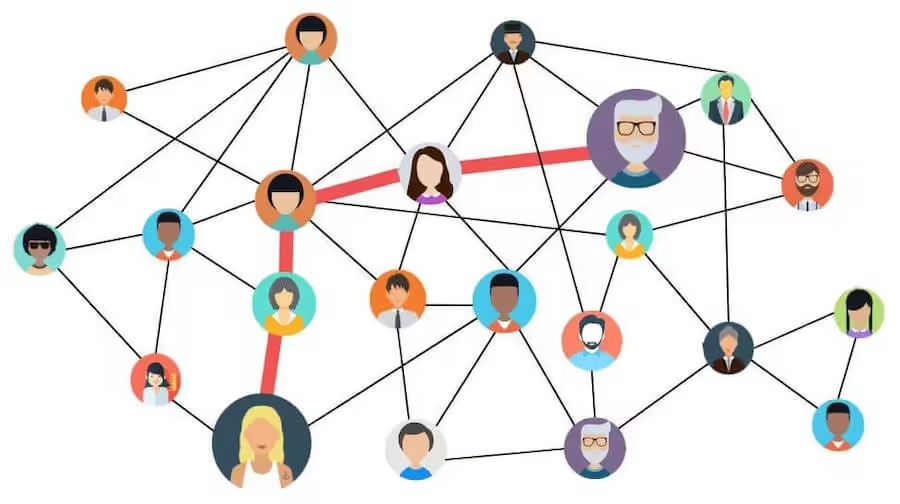What are virtual teams?
A virtual team is a group of people who interact using communication technology such as email, instant messaging, and video or audio conferencing services from different geographical locations.

Source: corporatefinanceinstitute.com
It is also known as a geographically dispersed team, distributed team, or remote team. Virtual teams rose in importance and quantity between 2000 and 2020, according to Gibson (2020), particularly in light of the 2020 Covid-19 epidemic, which required many workers to collaborate remotely with each other while working from home.
Virtual teams can be local or global. Local virtual teams have members who usually belong to the same company (big or small) with adequate resources (technology, internet) to establish and maintain the virtual team. Global virtual teams are located in different countries and cities worldwide, and they have common goals they want to achieve.
How to create a virtual team
Here are three simple steps on how you can create a virtual team:
1. Begin with the right people
The easiest method to ensure that your virtual team is made up of the proper people is to start from the beginning. Behavioral interviewing techniques and personality testing might help you find acceptable candidates. The following are some attributes to look for in virtual team members:
- Resilience
- Empathy
- Emotional intelligence
- Strong communication skills
- Autonomy in their work is important to them.
- Sensitivity to cultures different from one's own
If you take over a team, evaluate the member's strengths and flaws. Then, to fill any holes, create a training curriculum.
2. Get the right team size
Small groups of three to five persons are more efficient in general. They're also easier to manage, so if you've got a big group, consider breaking it up into smaller sub-teams.
3. Clarify the roles and responsibilities
Ascertain that your virtual team members are aware of their own and their teammate's roles and duties.
The future of virtual teams

Source: mymanagementguide.com
The COVID-19 epidemic has accelerated the trend toward virtual teaming, rising in the years running up to 2020.
By 2021, 66% of US workers will be working remotely at least once a week, and many people who previously worked in a co-located team will be working in a virtual setting. And the trend isn't going away: according to 451 Research, 64% of businesses expect remote work to become more prevalent in the future.
Fears that virtual teams would be less effective than traditional teams were misplaced, as 69% of businesses claim that at least 75% of their personnel can work efficiently from home. Furthermore, 78% of employees approve of the modifications. They provide individuals with more freedom and help them save time and money by reducing commuting time.
According to GitLab, 62% of respondents stated they would consider quitting a co-located firm favoring one with a remote work culture.
Types of virtual teams
There are several types of virtual teams depending on the virtual team members' goals, roles, and lifespan.
Networked Teams
A networked team is made up of cross-functional team members who are brought together based on their expertise and experience with a particular topic. New members can join the team as needed, and those who have already joined are withdrawn once their roles have been finished.
Parallel Teams
Parallel teams of members from the same organization form to provide recommendations for a process or system. Parallel teams are normally formed for a limited period, and their membership is stable since members of a parallel team stay together until the goal is achieved.
Product Development Teams
Product development teams are made up of professionals from all over the world who work together to complete a specific job, such as creating a new product, information system, or organizational procedure. Bringing in a team of experts from the United States, Canada, and Hong Kong to build a new engine for a year, for example.
Production Teams
Members of one position get together to undertake regular and continuous work in production teams. Production team members are assigned clearly defined duties and operate independently. The overall product is created by combining the distinct outputs of each member.
Service Teams
Members of service teams are from all around the world. Each person works alone, but the product they generate continues the previous member's effort. Customer service teams in Canada, for example, conclude their shift, whereas customer service employees in Asia begin their shift and continue working.
Management Teams
Management teams are made up of managers from the same company who work in different parts of the country. Members of management teams spend the majority of their time discussing corporate-level initiatives.
Action Teams
Action teams are formed for a limited period to respond to pressing challenges. The team is dismantled once the issue has been resolved.
Examples of virtual teams
Here are three examples of the most successful virtual teams from which you can get ideas of how to excel by replicating their success.

What they do: When the COVID-19 epidemic broke out in 2020, Google was one of the first corporations to provide work-from-home solutions. As employees returned to the office in 2021, they experimented with hybrid models.
How they do it: With 135,000 full-time employees worldwide, Google prioritizes employee happiness. They encourage teammates to be there and to congratulate one another on their accomplishments. They also have regular team meetings and check-ins and set team norms.
Airbnb

What they do: Airbnb closed its offices at the onset of the pandemic and is now offering all workers remote work alternatives until August 2021.
How they do it: Airbnb gave employees $500 to go toward a home office or ergonomic equipment. They also offered flexible work schedules and a $500 Airbnb voucher to help people temporarily relocate.
AppDynamics

What they do: Because AppD believes in employing great talent regardless of location, employees can work from one of its main locations, a satellite office, a coworking space, or from home.
How they do it: They did it by providing customized home office equipment to remote workers. They conduct ergonomic testing to ensure that staff works in the most comfortable and productive environment possible.
Advantages of virtual teams
Virtual teams might be difficult to adjust to for employees who work in co-located teams. Water cooler talks and unplanned coffee breaks are not possible with virtual teams. They also don't allow in-person brainstorming sessions or brainstorming sessions during breaks. As a result, we must change how we operate and collaborate with our co-workers. Is it worth the time and effort to adapt our teams and systems to remote work? Here are some of the advantages and disadvantages of virtual teams.
- There can be flexible work scheduling
- The lack of commuting
- Cost-saving, i.e. lower office costs
- Ability to care for family, pets, aging/sick relatives, etc.
- Reduced anxiety and/or stress
- Improved health (mental, physical, spiritual, etc.)
- Freedom to travel and relocate
- Ability to live where one wants to live
- Reduced office politics
- Increased productivity
- A 24-hour workday
- Greater availability of talent
According to GitLab research, 52% of virtual employees believe they are more productive, and 48% believe they operate more effectively. Furthermore, those with impairments or chronic illnesses can work from home and makeup 14% of the virtual workforce.
Disadvantages of virtual teams
Virtual team management, like anything else, comes with its own set of obstacles. One of the most significant is the increasing reliance on technology for virtual communication and work management. Although technical faults are unavoidable, they can cause delays and interruptions in the workplace.
Members in virtual teams don't get much time to get to know one another. This might result in misunderstandings and ineffective teamwork. Managers face a similar difficulty when it comes to virtual leadership, mainly if their virtual employees cannot communicate effectively. Thus, the summarised cons of virtual teams are:
- Technological issues
- Communication issues
- Poor team bonding
- Management problems
Virtual team challenges
Virtual teams across the globe face several challenges. However, there are solutions to mitigate the challenges, and these have been outlined below:
- Harder to collaborate with co-workers: Use communication and project management technologies to improve team productivity and eliminate errors. Hold virtual meetings regularly to ensure that everyone is on the same page.
- Interruptions: Designate a space in your home as your home office to reduce distractions. Request that your family or housemates refrain from bothering you during business hours. You might want to look for a place to work outside of your home, whether it's a coworking space or a pleasant cafe. If you're the leader of a virtual team, try distributing noise-canceling headphones to your co-workers to reduce distractions.
- Harder to stick to a routine: If you're having trouble sticking to a routine while working on a remote team, make a schedule based on your working hours. Managers who find their teams struggle with time management should consider enforcing defined work hours. Aim to wake up, go to bed, and eat your meals at the same time every day to help you stay on track with your work schedule.
- More difficult to stop working at the end of the day: Make a schedule for when you'll start and finish your workday. Then, make sure your co-workers, especially those in different time zones, know your working hours. You may set up an automatic notification for your teammates when it's time to log off as a leader.
- Feelings of isolation or loneliness: Host virtual get-togethers and coffee breaks if you're a virtual team leader. This will alleviate loneliness among employees and direct reporting.
- Poor Wi-Fi connection: Managers of virtual teams should think about reimbursing internet fees for virtual staff. This has the potential to increase productivity.
Wrapping it up
Both remote workers and their businesses can benefit from virtual teams. This is especially true if you know how to avoid or reduce the most common problems that arise when operating them. Choosing the right team members is the first step in forming a virtual team. Then it's all about cultivating clear and open communication in a trustworthy setting.
If you need support boosting your virtual team's performance, we have got an automated performance management system (Performance Manager) to assist you in ensuring that your virtual team is productive.
Kudzai Derera is the Business Systems Manager at Industrial Psychology Consultants (Pvt) Ltd, a management and human resources consulting firm.
LinkedIn: https://zw.linkedin.com/in/kudzaiderera
Phone: +263 242 481946-48/481950
Mobile: +263 773 523 084
Email: kudzai@ipcconsultants.com
Main Website: www.ipcconsultants.com

